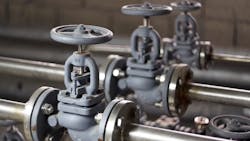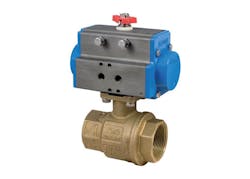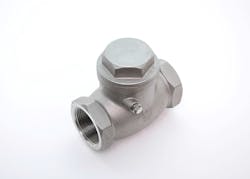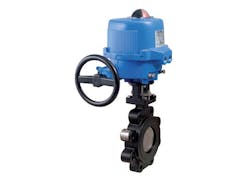Not all valves are equal: Picking the right material for the job
Valves come in numerous sizes and configurations and are used in thousands of applications across various industries. Likewise, there are various types of valves used in piping systems. These valves vary by operating mechanism/principle, function and design.
Most common valve types and applications
Ball valves: Ball valves are quarter-turn valves that can be used for flow stoppage or flow modulation. They contain a horizontally hollowed-out sphere sitting tightly in the middle of the valve. When the valve is open, the hollow side aligns with the flow. The valve can also be placed in a partially open/closed position. Ball valves work well in high-pressure applications.
Butterfly valves: Butterfly valves contain a flat disk/flap that swivels sideways to allow, block or regulate flow. These valves are often used in power plants and wastewater plants as shut off or regulating valves. While they are cheaper and smaller than ball valves, they are not good for high-pressure applications.
Check valves: Check valves allow the flow of media in one direction while preventing flow in the opposite direction. These valves typically have an inlet and an outlet port and operate using differential pressure. They are used to prevent reverse flow — a problematic phenomenon that can occur in piping systems, in which media flows in the wrong direction. This phenomenon can have profound implications such as problematic flow, contamination of the flowing media and damage to the piping system. There are various types of check valves, best suited to different applications.
Plug valves: In plug valves, cylindrical or conical plugs are used to control flow. The plug has a horizontal hole through which the media flows. To open the valve, the plug is rotated sideways to align the hole to the flow. Plug valves can commonly be found in radiators, heaters and air systems.
Gate valves: Gate valves are linearly operated valves that contain barriers referred to as gates. The gates are raised and lowered to open and close the valve, respectively. Gate valves are designed to be completely open or completely closed and are not suitable for flow regulation.
Globe valves: Globe valves consist of a globe-shaped disc that blocks flow by closing against an orifice. The globe is raised and lowered by an outside stem and yoke, otherwise known as OS&Y. Unlike gate valves, globe valves can be used to regulate flow as they can be partially opened and partially closed.
Common industrial uses of valves
Valves are used in numerous applications across various industries. The media, setup, working environment and overall requirements in these applications vary, and so a single type of valve cannot be suitable for all applications. Factors that should be considered when selecting a valve based on construction are pressure requirement, connection type, installation orientation, flow volume, flow direction, required level of control, accessibility and type of media.
Each of the valve types is best suited for particular applications. In addition to the requirements of the intended application, the following valve characteristics need to be critically evaluated before a valve design is selected: dimension and connection type, pressure drop, allowable leakage and coefficient of flow.
Valve materials and their applications
In addition to selecting the right design, it is also imperative to the success of a valve application that a suitable material is selected. Note that valve material refers to the valve body as well as the valve seats and seals. The following factors that must be considered when selecting a valve material are:
Temperature: Valves are often used in high-temperature applications such as waste heat recovery. In such applications, materials that can withstand high temperatures are required. Valves are also used in cryogenic applications such as the processing of liquified natural gas. Note that both operating (internal) and surrounding (external) temperatures are considered.
Pressure: Valves used in high-pressure or tensile, compressive and shear stress applications must be made of a material with adequate strength.
Flowing media: To prevent damage to the valve and contamination of the media flowing through it, it is crucial to use a valve material compatible with the media. Characteristics of the media that should be considered are corrosiveness, abrasiveness, viscosity and reactiveness. The surface roughness of the valve may also be critical in applications where precise flow rates are required.
Valve body materials
The following are some materials used to manufacture valves and their properties, applications, benefits and limitations:
Stainless steel: Stainless steel is a popular valve material. Its high oxidation and corrosion resistance, durability and superior mechanical properties make it suitable for numerous applications. Stainless steel valves do not rust and are excellent in steam, water, moist air, chloride and food and beverage applications. They also work well in high-pressure applications. They have good heat resistance but should not be used for extreme high-temperature applications. The downside of this material is that stainless steel is relatively expensive.
Carbon steel: Carbon steel costs less and is easier to manufacture than stainless steel. However, it does not possess the high corrosion-resistance quality of stainless steel. Carbon steel valves are excellent for applications that do not involve moisture. The extra carbon in carbon steel improves its abrasion resistance. Carbon steel valves also have satisfactory heat resistance.
Brass: Brass is often considered as a compromise between stainless steel and carbon steel. It is less expensive than carbon steel and is great for applications involving fuels, air, water and oils. However, its corrosion and heat resistance are lower than that of stainless steel, and more than that of carbon steel.
Monel: Monel is a nickel superalloy that has superb corrosion resistance. It performs excellently in seawater, salt and other saline environments. It is also resistant to certain chemicals. Monel valves are often used in concentrated corrosive environments.
Alloy 20: Alloy 20 is a stainless steel-superalloy hybrid. It is less expensive than most superalloys but is more corrosion resistant than stainless steel.
Inconel: Inconel has a very high resistance to oxidation and corrosion. This austenitic nickel chromium-based alloy can also withstand extreme pressures and heat.
Titanium: Titanium is a highly corrosion-resistant material. It is also highly resistant to most chemicals and thrives well in corrosive and reactive environments. Also, titanium valves can withstand extremely high temperatures. These valves are commonly used in nuclear power plants.
Alloy C-276: Alloy C-276 is a nickel-molybdenum-chromium alloy with trace amounts of tungsten. This solid solution-strengthened alloy is exceptionally resistant to corrosion and is compatible with a wide variety of harsh media and environments. Alloy C-276 valves are employed in extremely harsh chemical environments such as chemical processing plants.
PVC (polyvinyl chloride): PVC valves are mostly used in applications involving water. They do not corrode when exposed to chloride solutions, seawater, organic solvents and bases. However, they are not resistant to chlorinated hydrocarbons. PVC valves have low heat resistance with a maximum temperature of 60°C. These valves are often used in irrigation systems, domestic water systems, breweries and pools.
PP (polypropylene): Polypropylene is resistant to corrosive media such as aqueous solutions, acids and bases, and inorganic hydrocarbons. The resistance of this material does not cover oxidizing agents and concentrated acid. Like PVC, PP has low heat resistance with a max temperature of 80°C.
Valve seat materials
The valve seat material is just as crucial as the valve body. In certain applications, a slight leakage rate is allowable, and metal-to-metal (material-to-material) seats may be used. However, many other applications require complete sealing. In these applications, soft elastomer seats are used. Some commonly used valve seat materials are as follows.
Buna-N (nitrile rubber): Buna-N is the most ubiquitous elastomer for valve seats. Its wide usage results from its excellent compatibility with a wide range of substances, including water, oils and greases, hydraulic fluids, petroleum oils, glycols, alcohols, propane and butane. In addition to its wide compatibility, Buna-N has great compression strength and is resistant to tear and abrasion. However, it should not be used with chlorinated hydrocarbons and high polar solvents. This material can be found in many refinery valves.
EPDM (ethylene propylene diene monomer): Widely acclaimed as the most water-resistant runner, EPDM is widely used in water applications. It is also chemically resistant to alcohols, ketones, phosphate, glycols and other polar compounds. However, it should not be used with diester lubricants, aromatic fuels and petroleum oils. EPDM has good resistance to tear and abrasion.
FFK (fluorocarbon): FFK is a fluorocarbon elastomer that is often sold under the brand names Viton and Flourel. This material offers remarkable chemical compatibility with a wide variety of chemicals and is often employed in chemical processing. It is not recommended for use with steam.
PTFE: Popularly known under the brand name Teflon, PTFE is outstandingly resistant to abrasion, tear, chemicals, acids, alkalines and even fire. On the other hand, Teflon has limited strength and cannot withstand high pressure or large temperature variations. A variant of PTFE known as RPTFE can be used in high-pressure applications. This variant is reinforced with 15% glass-filled fiber. It reacts negatively with hydrofluoric acids due to its glass content.
Conclusion
Selecting the right valve materials for an application is crucial for the success of the application. There are many valve body and seat materials available today. These have a wide range of characteristics, benefits and limitations. The consideration of these, along with the requirements of the application, will always ensure the best materials for a particular application.
Gilbert Welsford Jr. is the founder of ValveMan.com and a third-generation valve entrepreneur. He has learned valves since a young age and has brought his entrepreneurial ingenuity to the family business in 2011 by creating the online valve store — ValveMan.com.
About the Author
Gilbert Welsford Jr.
founder of ValveMan.com
Gilbert Welsford Jr. is the founder of ValveMan and a third-generation valve entrepreneur. He has learned valves since a young age and has brought his entrepreneurial ingenuity to the family business in 2011 by creating the online valve store — ValveMan.com.



